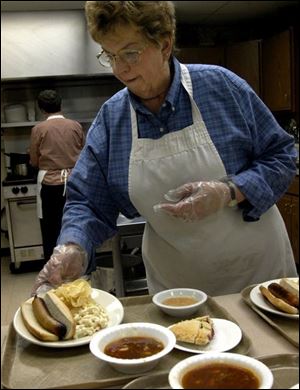
Homelessness in rural areas often a hidden ill
12/19/2004
Bob Mazey eats his dinner at the City Mission in Findlay.
Luke Wark / The Blade
Buy This Image

Bob Mazey eats his dinner at the City Mission in Findlay.
FINDLAY - Bob Mazey moved to Findlay in September, lured back to his hometown from Florida by the promise of a job and a place to stay.
He went to work installing windows and performing other construction tasks, and became a tenant at his new boss' home. But the weekend before Thanksgiving, Mr. Mazey fell ill.
Angered that his new employee couldn't work that Monday, his boss fired him and ordered him out of his house. Mr. Mazey, 31, was homeless.
"I worry about what's going to happen to me," he said Thursday night while eating a dinner of bratwurst, vegetable soup, and applesauce at the City Mission, a Findlay homeless shelter. "I want to wake up in one place that's home."
Shelter operators and social service agencies say a growing number of Ohioans exist on the edge of homelessness - including the rural poor. The state does not keep statistics on the number of homeless people, but shelters in northwest Ohio say they're serving more people, in part because of a sluggish job market.
Ohio's unemployment rate rose from 6 percent in October, 2003 to 6.3 percent in October, 2004, according to the latest state figures. Area counties with the highest jobless rates include Huron (7.9 percent), Allen (7.2 percent), Lucas (7.1 percent), Seneca (6.8 percent), and Williams (6.1 percent).
According to the Census Bureau, 12.1 percent of Ohioans lived in poverty in 2003, up from 11.9 percent in 2002, and 11 percent in 2001.
In Michigan, the situation is similar. The state's jobless rate rose to 7 percent last month, while the percentage of residents living in poverty was 11.4 percent last year. The state's poverty rate was 11.6 percent in 2002 and 9.4 percent in 2001.
An illness, car trouble, or some other setback can make it impossible to hold a job and pay rent. Substance abuse, relationship breakups, and domestic violence also can lead people (and their children) to suddenly lose their home.
"Homelessness can happen to almost anyone," said Diane Hale, emergency assistance manager for the Hancock, Hardin, Wyandot, and Putnam Community Action Commission in Findlay. And, she added, that's true even in a relatively prosperous area like Hancock County, where the October jobless rate was 4 percent.
But rural communities often need to be persuaded that a homeless problem even exists. In areas like Fulton County, the homeless don't fit the urban stereotype of a shabbily dressed person pushing a shopping cart of belongings down the street, said Cecily Rohrs, director of Friendship House, a privately funded, two-family shelter in Archbold that has been full most of the time since opening in June, 2002.
"There are still people in northwest Ohio who say there can't be homeless, and the reason is out here they look just like us," Ms. Rohrs said. "They're wearing jeans and a sweatshirt, but they spent the night in a factory parking lot, sleeping in a car."

Marilyn Lazenby of Findlay sets down a plate of food as she gets ready to serve dinner at City Mission in Findlay. Ms. Lazenby has been the full-time cook at the mission for five years.
Ms. Hale said her agency has seen a surge in requests for help with housing issues. As of Dec. 2, it had provided housing assistance to 269 people this year, up from 188 for all of last year. The agency works with low-income wage-earners to help them move into a new home or avoid eviction in the first place.
HHWP will provide up to $450 toward a prospective tenant's first month of rent and security deposit, provided the person has a job, enough income to pay the rent, and a signed lease.
"We don't want them to be defeated and have to end up moving out again," Ms. Hale said. "We want them to be able to afford it."
Program participants also must meet income guidelines. For a family of four, the annual limit is $20,825.
Tenants facing eviction for falling behind on rent can receive similar payments to help them make back payments, if the landlord is willing to work with HHWP.
"If they need more money, we have other agencies in our area we give them referrals to," Ms. Hale said.
At Findlay's City Mission, the 31-bed facility allows emergency stays of up to seven nights per month for Hancock County residents and three nights for transients. A person who holds a steady full-time job can stay in the mission's long-term unit for 30 to 120 days if he agrees to put his earnings in a "housing fund" that can be used to pay security deposits and other startup costs for an apartment.
"We have people come out of here who have saved $2,000," said Jim Davidson, one of the shelter's directors. "You can get a pretty good start with that kind of money."
But finding full-time work in northwest Ohio's sluggish job market isn't easy for people like Mr. Mazey, who dropped out of high school for a factory job. During a 1 1/2-year stay in Ocala, Fla., he worked as a day laborer and short-order cook, but he's had no luck landing a job in Findlay the last few weeks.
Facing his last night at the shelter Thursday, Mr. Mazey said he didn't know where he would stay and worried that being out on the street would make it even harder for him to get hired.
"I'm going to try to stay in Findlay, as long as I don't freeze," he said.
At the shelter, he could have potential employers call him there and keep his two duffel bags of possessions there instead of lugging them around with him while applying for jobs - a dead giveway of his precarious situation.
"You walk into Burger King with those bags and ask for an application, and they look at you and say, 'Are you homeless,' " he said. "I'm not the smartest man, but I'm a good worker. I'm going to keep looking for work."
After losing his construction job and his place to stay last month, Mr. Mazey moved in with a relative in Dunkirk, about 18 miles south of Findlay in Hardin County. But Mr. Mazey said his relative's heavy drinking was a problem for him, a recovering alcoholic, so he left Dec. 3 and headed for the City Mission in downtown Findlay.
"I walked it in the rain," Mr. Mazey said. "It took me about four hours."
A lack of transportation cost Isaiah Rayle, 21, a job at Consolidated Biscuit Co. in McComb last year. Mr. Rayle said he worked there for about six months while staying with an aunt and uncle who lived a mile from the plant, close enough for him to walk.
But he moved to Findlay because of disagreements with his relatives and couldn't always find a ride to work.
Mr. Rayle was out of work for several months and recently found part-time work at a Findlay convenience store.
Lacking a permanent home, he stays with friends, outside, or, periodically, at City Mission, where he went Wednesday as temperatures dropped below freezing.
"I'm trying to save up enough money to get a place," he said during dinner at the shelter Thursday. "It's getting cold out, and when your seven days here is up, what are you going to do then?"
Homeless people who live outside the Toledo area in northwest Ohio have few options for emergency shelters. Some counties have no such facilities, and often a shelter such as City Mission is the only one in its county.
Counties including Henry, Huron, Ottawa, Putnam, and Wood have no homeless shelters.
Kathy Cavanaugh, director of Williams County's only homeless shelter, the Sanctuary of Williams County in Bryan, said her 18-bed facility has been full since spring. She said the next closest shelter that will take out-of-county residents is the PATH Center in Defiance.
"If I know PATH Center is full, I have nowhere to refer them," she said. "I can refer them to Toledo Rescue Mission, or to Lima, the Rescue Mission for Men, and then there's Jackson, Mich. And that's it. That's really bad."
In such cases, Ms. Cavanaugh will call around to the dozen Williams County churches that support her shelter and try to find someone to drive her client to Toledo, Lima, or Jackson.
Elsewhere in the region, advocates for the homeless are trying to meet the increased demand by starting shelters or expanding existing centers.
In Fremont, the 10-year-old Liberty Center will open a new and much larger shelter to residents Tuesday. The 4,800-square-foot facility on East State Street replaces a 900-square-foot shelter on Tiffin Street.
Margaret Weisz, the center's director, said the new shelter will be able to house up to 30 people, up from a capacity of 12 at the previous site. The new Liberty Center, was bought and renovated at a cost of about $400,000, with much of the money coming from state grants.
The facility is handicapped accessible and includes carpeted bedrooms with stylish wooden bunks, three spacious family rooms, and a children's play room painted in bold reds, blues, greens, and yellows.
The new center will be perfect for its temporary tenants, Ms. Weisz said. "In the rural area, they're mostly families," she said. "The majority of the people we see are single women with children."
A coalition in Fulton County has been working since spring to open a shelter in Wauseon. Friendship House in nearby Archbold serves mostly residents of the local school district.
Ms. Rohrs, director of Friendship House, said she decided Archbold needed a shelter in May, 2000 when two families in the school district lost their homes.
"I just felt every school district in the county needed a modest home where people can go and regroup," she said, adding it is hard on children when they are forced to leave their school districts.
Paul zumFelde, western region director for Lutheran Social Services, is leading the effort to establish a shelter in Wauseon.
Organizers hope in the next month to be recognized as a nonprofit by the Internal Revenue Service and begin raising money to buy and renovate a house in Wauseon. "The reality is that we all recognize that there's a problem and it needs to be solved locally," he said.
Contact Steve Murphy at: smurphy@theblade.com or 419-724-6078.